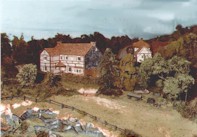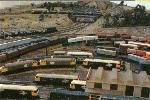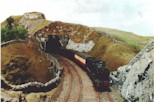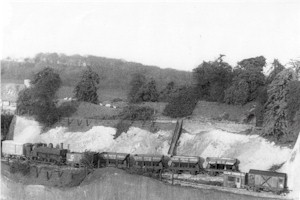
C
OUNTRYSIDE MODELSWhat you can expect for a budget of
over £25,000.
trainMost people opting
for this price range have had some experience with a model railway and have a pretty good
idea what they want.v Let's find out if we are talking the
same language. . . |
| professional model railways builder, model railway designer |
Briefly: the answer of what you get for spending more money is also fairly simple; you can have something after the style of Westbury or Tupdale but bigger or better. Possibly, if you don't go too mad, you can have both bigger and better! |
railwaysOf course, that's over-simplifying
things! A better answer is that you can expect to get a larger and more
impressive model railway, or you can have something similar but to a much higher standard.
railwaysAt higher prices, the size of the model is
not necessarily the most important factor in deciding what it will cost you, it is the
amount of railway and the amount of housing/buildings which determine the price.
 |
railwaysA good, hand-made model of a
farmhouse can be as complex as a station building and cost as much - which might be a
thousand or more - while even a cottage will not be a lot less - so if it is a whole
village you want it might cost more than the railway aspect of the model. This is
not necessarily a bad thing; many people enjoy owning a beautiful model more than they
enjoy operating it - and remember, the less railway there is, the less time you will spend
in maintenance. Not, I hasten to add, because what we build needs maintaining but
because unless you have hand-built engines made to our standards you will need to clean
both track and trains regularly. Worth bearing in mind when you allow yourself to
"pipedream" about your ideal model.
O.K. let's offer a word or two on the major scales.
 |
2mm scale Be it 2mm scale or good old-fashioned "N-gauge" the potential in this small scale of producing large, wonderfully scenic models is enormous! Stations the size of say Plymouth North Road or Hellifield become eminently possible along with all the surrounding scenery. In such a small scale however, it is undoubtedly worthwhile to pick a location with dramatic scenery to make full use of the space.
 |
4mm scale This might mean a model such as Tupdale but built with hand-made track to 00, EM or P4 standards, with more of a mainline run and more impressive scenery spread over a much larger area. A budget such as this also allows you to seriously consider some hand-made rolling stock; perhaps ours, perhaps somebody elses (although we hope you will take our advice on standards) or perhaps even your own, if that side of model-making does (or has?) taken your fancy. It must be remembered however that the nearer to scale you go, the more room you will need. P4 for example (which, with a gauge of 18.83mm, is precisely to scale in 4mm), needs radii of at least 4 feet and for mainlines, 6 feet plus is much better for reasons both visual and technical. There is no doubting the fact mind; P4 really is the ultimate in realism in this scale.
 |
7mm scale This is a realistic budget for a fair-sized "0" gauge model railway. Something which perhaps would look similar to Westbury or Tupdale - but only if you have enough room. 7mm scale may be less than twice the size of 4mm scale but it needs larger than twice the radii - and that's a fact of life, not an excuse for poor model-making! With mainlines needing between 6 & 10 feet (depending on whether you opt for ordinary [what Peco call "finescale"], 0 gauge or "7scale" you will need a room at least 13' by 14' for a mainline layout and preferably rather more. If you have length but not width, branch termini of considerably narrower sizes are quite feasible but there is no getting away from the fact that 7mm scale, whatever the standards, is both expensive and space-hungry!
All Scalestrains
For those with the larger budget, the first thing we do is try to find a real station
which will suit your requirements for period, owning company, location, operational
preferences etc. and then we look at the size of room you have to put it in. If it
fits, or can be made to fit with a little careful compression, then we suggest you have a
model of that station since there really is nothing as good as a model of
a real station, even if it has to be "compressed" a little. (There is
some argument about this statement - click here
to look at our "Why choose an actual prototype" section if you
disagree!)
trainsIf nothing suitable can be found, we look at a
prototype line of railway and find features along it which can be combined to make a
suitable model for you. Only once these two possibilities have been exhausted will
we consider making an "imaginary" design for you - even then we do our utmost to
base the model on reality with regard to location and the trains which are to run on
it.
trainsIn other words, we have to do a lot of research.
All this takes time and in some cases, not only do we have to read books, we have to buy
more books or post off enquiries to authors or authorities on particular railways and
await their replies before even beginning to come up with a design for you.
And all this we are prepared to do for nothing! So; all we want to know now is,
"How can we help you"?
Why not fill in our questionnaire and we will see what we can do for you!
| Thanks; that's all I want on costs for now. | Back to previous page | Home page |
lots of text to make a hole